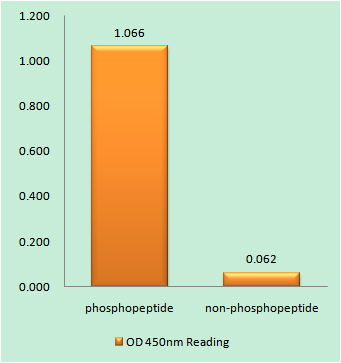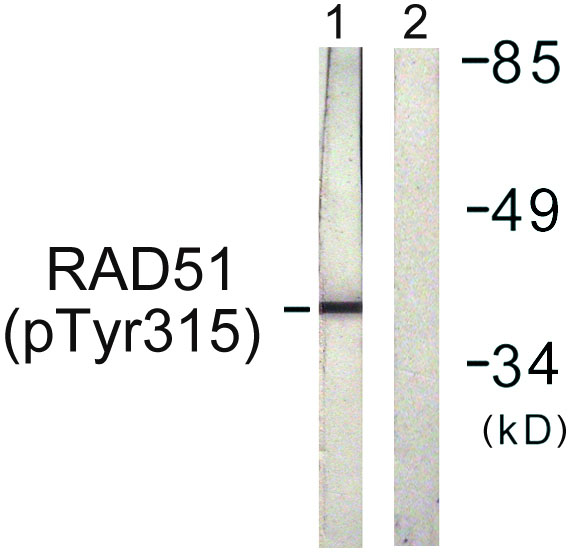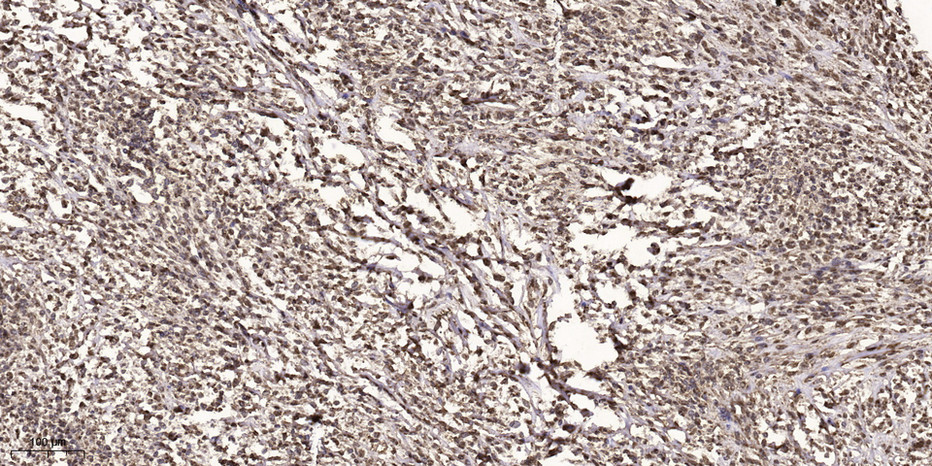Rad51 (phospho Tyr315) Polyclonal Antibody
- Catalog No.:YP0376
- Applications:WB;IHC;IF;ELISA
- Reactivity:Human;Mouse
- Target:
- RAD51
- Fields:
- >>Homologous recombination;>>Fanconi anemia pathway;>>Pathways in cancer;>>Pancreatic cancer
- Gene Name:
- RAD51
- Protein Name:
- DNA repair protein RAD51 homolog 1
- Human Gene Id:
- 5888
- Human Swiss Prot No:
- Q06609
- Mouse Gene Id:
- 19361
- Mouse Swiss Prot No:
- Q08297
- Immunogen:
- The antiserum was produced against synthesized peptide derived from human RAD51 around the phosphorylation site of Tyr315. AA range:281-330
- Specificity:
- Phospho-Rad51 (Y315) Polyclonal Antibody detects endogenous levels of Rad51 protein only when phosphorylated at Y315.
- Formulation:
- Liquid in PBS containing 50% glycerol, 0.5% BSA and 0.02% sodium azide.
- Source:
- Polyclonal, Rabbit,IgG
- Dilution:
- WB 1:500 - 1:2000. IHC 1:100 - 1:300. ELISA: 1:10000.. IF 1:50-200
- Purification:
- The antibody was affinity-purified from rabbit antiserum by affinity-chromatography using epitope-specific immunogen.
- Concentration:
- 1 mg/ml
- Storage Stability:
- -15°C to -25°C/1 year(Do not lower than -25°C)
- Other Name:
- RAD51;RAD51A;RECA;DNA repair protein RAD51 homolog 1;HsRAD51;hRAD51;RAD51 homolog A
- Observed Band(KD):
- 37kD
- Background:
- The protein encoded by this gene is a member of the RAD51 protein family. RAD51 family members are highly similar to bacterial RecA and Saccharomyces cerevisiae Rad51, and are known to be involved in the homologous recombination and repair of DNA. This protein can interact with the ssDNA-binding protein RPA and RAD52, and it is thought to play roles in homologous pairing and strand transfer of DNA. This protein is also found to interact with BRCA1 and BRCA2, which may be important for the cellular response to DNA damage. BRCA2 is shown to regulate both the intracellular localization and DNA-binding ability of this protein. Loss of these controls following BRCA2 inactivation may be a key event leading to genomic instability and tumorigenesis. Multiple transcript variants encoding different isoforms have been found for this gene. [provided by RefSeq, Aug 2009],
- Function:
- disease:Defects in RAD51 are associated with breast cancer (BC) [MIM:114480].,function:May participate in a common DNA damage response pathway associated with the activation of homologous recombination and double-strand break repair. Binds to single and double stranded DNA and exhibits DNA-dependent ATPase activity. Underwinds duplex DNA and forms helical nucleoprotein filaments.,PTM:Phosphorylated. Phosphorylation of Thr-309 by CHEK1/CHK1 may enhance association with chromatin at sites of DNA damage and promote DNA repair by homologous recombination.,similarity:Belongs to the recA family.,similarity:Belongs to the recA family. RAD51 subfamily.,similarity:Contains 1 HhH domain.,subcellular location:Colocalizes with RAD51AP1 to multiple nuclear foci upon induction of DNA damage.,subunit:Interacts with BRCA1, BRCA2 and either directly or indirectly with p53. Interacts with XRCC3, RAD54L an
- Subcellular Location:
- Nucleus . Cytoplasm . Cytoplasm, perinuclear region. Mitochondrion matrix . Chromosome . Cytoplasm, cytoskeleton, microtubule organizing center, centrosome . Colocalizes with RAD51AP1 and RPA2 to multiple nuclear foci upon induction of DNA damage (PubMed:20154705). DNA damage induces an increase in nuclear levels (PubMed:20154705). Together with FIGNL1, redistributed in discrete nuclear DNA damage-induced foci after ionizing radiation (IR) or camptothecin (CPT) treatment (PubMed:23754376). Accumulated at sites of DNA damage in a SPIDR-dependent manner (PubMed:23509288). Recruited at sites of DNA damage in a MCM9-MCM8-dependent manner (PubMed:23401855). Colocalizes with ERCC5/XPG to nuclear foci in S phase (PubMed:26833090). .
- Expression:
- Highly expressed in testis and thymus, followed by small intestine, placenta, colon, pancreas and ovary. Weakly expressed in breast.
- June 19-2018
- WESTERN IMMUNOBLOTTING PROTOCOL
- June 19-2018
- IMMUNOHISTOCHEMISTRY-PARAFFIN PROTOCOL
- June 19-2018
- IMMUNOFLUORESCENCE PROTOCOL
- September 08-2020
- FLOW-CYTOMEYRT-PROTOCOL
- May 20-2022
- Cell-Based ELISA│解您多样本WB检测之困扰
- July 13-2018
- CELL-BASED-ELISA-PROTOCOL-FOR-ACETYL-PROTEIN
- July 13-2018
- CELL-BASED-ELISA-PROTOCOL-FOR-PHOSPHO-PROTEIN
- July 13-2018
- Antibody-FAQs
- Products Images

- Enzyme-Linked Immunosorbent Assay (Phospho-ELISA) for Immunogen Phosphopeptide (Phospho-left) and Non-Phosphopeptide (Phospho-right), using RAD51 (Phospho-Tyr315) Antibody

- Western blot analysis of lysates from Jurkat cells, using RAD51 (Phospho-Tyr315) Antibody. The lane on the right is blocked with the phospho peptide.

- Immunohistochemical analysis of paraffin-embedded human small intestinal carcinoma tissue. 1,primary Antibody was diluted at 1:200(4° overnight). 2, Sodium citrate pH 6.0 was used for antigen retrieval(>98°C,20min). 3,Secondary antibody was diluted at 1:200
